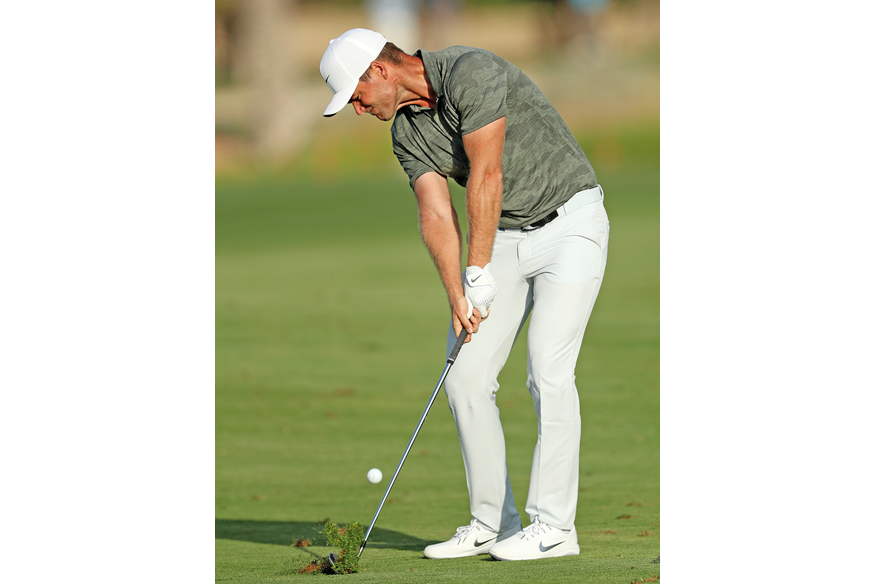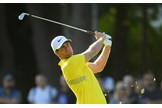Iron play with Lucas Bjerregaard
Last updated:
Lucas Bjerregaard reveals his time-saving tips for better ball striking
Lucas Bjerregaard knows better than most how unpredictable golf can be. Tipped for big things after beating Tommy Fleetwood to win the European Amateur in 2010, the Dane had just three Nordic Golf League titles and two missed cuts from three Major appearances to his name in the seven years that followed.
It wasn’t until he won on his 111th European Tour start at the 2017 Portugal Masters that his career finally took off and people started taking notice.
Last year was Bjerregaard’s most successful and saw him hold his nerve to win the Alfred Dunhill Links, beating Fleetwood and Tyrrell Hatton by one shot in October. He finished the season 13th in the Race to Dubai with more birdies and top 10s than anyone else on the European Tour.
He’s continued that form into this year, memorably beating Tiger Woods in the WGC-Match Play and earning his PGA Tour card.
Here, he talks you through his keys to hitting great iron shots.

My long game is the part I work on the most. I grew up playing in fairly windy conditions, so that’s probably helped me in being able to control my ball trajectory. When the wind is into my face, I’ll take a club extra and then grip down a little bit, narrow my stance and move the ball back ever so slightly. I will then look to make a three-quarter swing, but with quite a slow pace. If you hit it hard, the ball will spin, get caught in the wind and go nowhere. If I have a feeling that by hitting a hard 7-iron, I can get it there, I will take a 6-iron and hit it soft.
A lot of amateurs go to the range and only ever hit full shots. OK, it might be the shot you hit the most, but when we go to the range we work on those three-quarter shots. When I do tests on Trackman, I give myself numbers which aren’t perfect so I have to hit a little 8 or 7-iron, and work on those knock-down shots.
Having a repeatable pre-shot routine is very important. I used to throw a bucket of balls down and barely see where the previous ball landed before hitting my next one. Now, I’m trying to make each shot count by going through the same routine. I always have some kind of goal or target for where to start the ball and where I want it to finish. That way my practice is more course-like. That’s helped me a great deal.
I try to replicate the pressure of competition by playing games or having bets with my caddie. I use my Trackman quite a bit and set up games with a score. So, let’s say I’m trying to hit it 150 yards or to a specific target, I will get a score if I hit it within a certain area. I do that a lot on my own, but you could easily do it without a Trackman. When I’m hitting my driver, for example, often I will create an imaginary fairway by using flags or signs on the range. I will then hit five shots and tell myself that I need to hit four in the fairway before I can move on.

How often do you see a mid-handicapper hit a good shot, and just miss the green on the wrong side? Out of nowhere, it can be easy to make a double bogey or worse. It’s about being smart and knowing when to play away from the trouble a little bit. It’s an important part of what we do every day on tour and most amateurs don’t give it enough credit.
Whenever I’m considering a lay-up on a par-5, I will always look where the pin is. If it is at the back, I will normally try to get close with my second so I can chip it on and run the ball towards the flag with my third. But if the pin is at the front, I would much rather leave myself 90 yards than 45 yards. That’s because it’s a full shot and a yardage I’m comfortable with. We all know how hard a 45-yard shot is, especially over water or a bunker. No one likes that. I’d rather have a full shot so I have control. That’s what me and my caddie talk about whenever we’re thinking about laying up on a par 5. Most amateurs probably think, “how close can I get it to the green?” In other words, they’re thinking about the second shot more than what’s to come after that!
I think 90 per cent of amateurs could benefit from making sure their set-up is correct. Most golfers I play with in pro-ams swing out-to-in and suffer with a slice, and then make it worse by aiming further right and coming over the top of the ball. That’s why using tour sticks or asking a coach, friend or caddie to check your alignment is so important. I’ve always preferred to change my set-up so I don’t have to mess about or change my swing too much.
What I see a lot is people standing too wide with shorter clubs, and playing the ball too far forward. You would be far better off taking a narrow stance, and making sure the sternum is over the centre of the ball. That determines where your low point is, and where the swing bottoms out. If the ball is positioned too far forward, it’s easy to bottom out too early, which means you’ll either fat it or thin it.
Try to feel like you’re hitting down on the ball, even with a 9-iron. There’s enough loft to get the ball airborne; you don’t need to help it. Trusting and believing that is key. With a driver, you want to hit it on the up, but with irons you need to hit down with a negative attack angle.
My stance widens as I move from a wedge to my 4-iron. I want to hit it harder, so a wider base gives me that greater stability. I’ll also tend to move the ball further forward in my stance, but that does depend on the shot I’m trying to play. For example, if I’m trying to hit a low draw, I’ll play the ball back in my stance. But then if I want to hit a fade, I’ll move it further up to make sure the path is going to the left.
Ball position is more important than shaft lean. If the ball is already forward in your stance, it can be hard to keep your hands ahead of the ball. Whereas, if you keep the ball position back, the hands will automatically be forward. I would say the sternum is more important than your shaft lean at setup. As long as the sternum is over the ball or just in front, you will get good contact. In theory!
If you struggle with long irons, take a hybrid. A lot of people are probably too proud. I certainly was growing up. I had a blade 2-iron and I was like, ‘I’m not getting a 2-hybrid; I’m using this 2-iron because Tiger does.’ I think it was a pride thing, but hybrids are so much easier to hit now with modern technology. I’ve got a 2-hybrid and 5-wood in my bag now. I realised that there’s no reason to make it harder for yourself. Most amateurs don’t need a 3-iron. They are far better off with a hybrid which will help them to get the ball in the air a lot easier.
When I’m hitting a fairway wood or hybrid off the deck, I will take a small divot. A lot of amateurs seem afraid to do so, and they are probably conscious of being told that you need to sweep the ball off the turf. But if you hit too much on the up, it makes it easier to top it.
I normally only have two triggers when I’m making a swing. You don’t really want anymore than that. I have one swing thought when I go back, and one on the way down. At the moment, I’m thinking about my right arm. I have a tendency to flare the elbow out, so I’m conscious about keeping it folded and tucked in on the way back. That way I know my backswing is good.
Trust and know what you’re working on. My dad has a 12 handicap and when he starts out with three or four pars, he will tell me that what he’s been working on is the best thing ever. But then if he goes and hits his next shot out of bounds, he will be trying something completely different on the next hole. I think a lot of people can relate to that, and would benefit from working with their local pro to get a better understanding of their swing. That way if things do start going wrong on the course, you know what the cause is. One of the biggest things for me last year was gaining a better understanding of my swing. My miss is right, and I know it’s always one of two things. That means I don’t have to worry for the next nine holes about where that shot is coming from. I can just make the necessary adjustments to fix it on the next shot. If most amateurs had that same feeling, I guarantee they would play a lot better.



